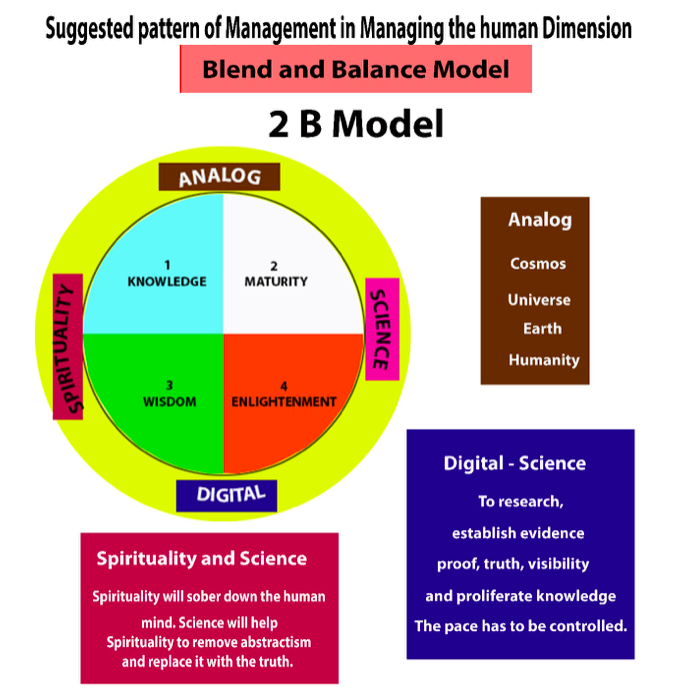
For thousands of years, Knowledge Development was restricted to faith, belief and verbal authority. This later evolved into Science and Technology with their thrust on evidence, proofs and facts with visibility.
In times today, when digital technology is galloping ahead at a rapid pace that’s also shrinking distances in a highly net worked cybernetic world. The growth in Knowledge Development has been phenomenal.
There’s been no looking back at the slew of developments brought to the life styles of the people the world over. Needless to say, that it has broken all barriers between people, paving the way for a fellowship in humanity that can also be thought of as ‘One world, One Humanity’.
The journey in Knowledge Development can be traced back to the discovery of the Electron in 1897 by J J Thompson, which further led to the discovery of microelectronics, the microchip and computers. And therein came a star burst of inventions in the realm of digital technology. What a ‘Mighty Positive Impact’ has the Electron or the ‘Tiny Negative Charge’ made to the world!
In a scenario when we are fast homing into Artificial Intelligence and Robotics, there’s no denying the many inconsistencies creeping into the social order which have to be addressed because of the many disruptions setting in. Given that livelihoods would be affected on the one hand, as well as more luxuries becoming available at the touch of a button. What exactly are the social implications of knowledge explosion? What of the ‘Human Dimension’? Come to think of it, what would happen if robots actually took over humans?
Therefore, it would be necessary to draw the distinction between life styles to be maintained and the extent of luxuries we indulge in because of the tremendous impact of digital technology on all areas as in Medical, Physical Fitness, Education and more. What is it that would have to be done to maintain a balance between speeding digital technology and the human dimension?
In truth, it’s high time to reassess, redefine and change our views on Management.
Reinventing Management
Science knitting hands with Spirituality
Management as a field in itself is a vital ingredient in the wheel of Knowledge Development and achievement. And it’s verily the human mind that has created everything from Spirituality to Science to Digital Technology and Artificial Intelligence and more. Needless to say, that it would be the human mind again that would have to find a way of balancing advancing digital technology with the human dimension.
The answer would lie in striking the perfect balance between Analog and Digital on the one hand and between Spirituality and Science on the other.
While Knowledge can be taught, learnt and communicated, Wisdom, Maturity and Enlightenment are analog and depend on the human dimension. They cannot be learnt and taught as in the case of Knowledge. However, it will be Wisdom, Maturity and Enlightenment which are the crucial factors that will bring in the necessary balance in life.
With Digital Technology making its arrival, there’s no mistaking the number of people who are going to be impacted on their livelihood. Are businesses then only about profitability or are they also about placing a certain value on the human being?
The concept of ‘wealth’ alone as a measure of success would indeed have to be re-examined and reassessed. The deployment of automations and robotics would have to be related to the human population in order to take care of the livelihood of humanity.
So, if we have to consider having a meaningful blending of the old values with the Human Dimension best suited for the times of the present day, we come to the participation of spiritual leaders in relation to the Management philosophy of tomorrow, which is imminent.
What kind of spiritual leaders do we consider?
The inevitable question that would then arise would be as to the kind of spiritual leaders that we have to deliberate upon to be most appropriate for consideration. Who are the spiritualists who can best contribute to this with their experience in this world? What is it that it would take of a spiritual leader to be to help with the Human Dimension in the present era and age?
Spiritual leaders who have lived, evolved and created their philosophies on human values through the 19th century onwards are the best to consider. In my opinion Arch Bishop Desmond Tutu and the Dalai Lama are typical examples of persons who could be considered as they both advocate the oneness of humanity. Such spiritual leaders would be ideally suited and most compatible to contribute significantly.
As an Indian born, I am aware of the Vedanta philosophy and its interpretations by the distinct luminary Swami Vivekananda. His philosophy was applicable to all human beings regardless of nationality, caste, race, community and faith. I would consider his philosophy to be most relevant, appropriate, adaptable and compatible with the present-day scenario.
Being an ardent follower of the legendary Guru Peter Drucker of the Occident and his philosophy, I would like to consider his philosophy as well because, his is an institution that’s well known for constantly updating their thinking on management in relation to the prevailing times.
And I wish to humbly suggest the blending of the philosophy of Peter Drucker of the Occident with that of the Vedanta philosophy of Swami Vivekananda.
Why the 2 B Model?
Humans are a combination of many different kinds of mind sets. So, with change the norms for accessibility and acceptance will also change and the only saving grace would be eternal values, virtues and the usefulness of different ideologies and mind sets. Because these can with stand changes and find continuity in some form or the other.
This also holds good for Management ideologies and the old norms of management philosophies. These ideologies basically entailed the reduction of human labour and laid emphasis on automation and mechanization. This method will again work for a period of time. But now after almost two centuries of management experiences, the world is waking up to the necessity of giving importance to the human dimension.
Therefore, to come to a new acceptable form in management philosophy, it’s necessary to bring together the essential values and usefulness of many ideologies and work out a common new standard, norm or a scale of reference.
This would also have to accept the basic truth that knowledge development, change and progress are eternal and will continue to impact all practises and ideologies continuously. It will be only through mutual interaction that human minds can formulate new accepted methods so as to arrive at the balancing acts so required.
The past two decades have set all minds thinking and many experts have brought forth their views. Although I don’t claim to have any expertise, I felt that as a human mind, standing by and observing this, I can come up with what I feel needs to be done! And therein came the 2B Model!
It should not be forgotten that the business man, the management man and the customer are all only human minds!
Broad Guidelines for Redefining Management
The 2B Model
The 2 B Model is not an immediate solution for today or tomorrow.
However, it will help shape a new line of thinking in terms of new concepts for businessmen and management consultants, corporates and industry at large.
What needs to be done to maintain and preserve the stability of the Human Dimension in the long run would be as follows:
It would require the help of:
Spiritualists and Ascetics, Human Science professionals and of course a new league of Management Consultants with a changed outlook.
When we speak of People or the Human Dimension what we are referring to are:
- Civilians – ordinary citizens
- Others – Businessmen, professionals as in Doctors, engineering consultants
- Defence Personnel like Army, Navy, Airforce etc
There are two main categories in ordinary citizens which are:
- the Rich and the Poor
- The employed and the unemployed
Key figures coming under the arc lights
- Businessmen
- Management consultants
- Human Science professionals
Areas of Speed and Time concerns
- Defence
- Medical
- Security
- Other emergencies
You have to be fast and quick in the areas of Defence, Medical, Security and other emergencies.
How do you begin?
1.Educate and change mind sets of businessmen.
2. Bang for the buck! How much bang will you get for every buck invested?
3.Give and take attitude.
A business man must have a give and take attitude. The bang should afford and accommodate those humans deprived of their livelihood. All of these are highly time consuming.
What must be done
Select
Human values and virtues suited for evolving new management thinking, new corporate definitions etc.
Calculate
The percentage of humans deprived due to automations.
The cost of automations.
The cost of deprivation.
So how do you go about this?
One of the methods to go about this would be:
1.First plan with ‘human labour’.
2. Plan with normal practises like as in with automations etc.
3. The difference in cost between the two will show the cost of deprivation.
The ideal examples for automation have been entertainment equipment like Television cassettes, CD’s besides mobile telephones. These are typical examples where high automations are followed.
The urgency, speed and quality of production have been mostly motivated by the desire of people to have more comforts and pleasures. Similarly, production of cars, scooters etc follow.
There should be a concerted effort to educate people to be moderate in enjoying luxuries and comforts. They must also wait for the need to buy such products without depriving other human beings of their livelihood.
And finally, a new norm and basis of Management can be worked out after establishing a base data, which is acceptable. It has to be tried by applying.
Again, highly populated countries should be given a separate management education. Methods used earlier on may still work out in less populated countries. Management techniques will have to vary from highly populated countries to sparsely populated countries. Again, products churned out by people at the grass roots in any region, which are wrought by the hands without the use of automations need to be preserved, treasured and encouraged. They need to be protected from dying out due to the invasion of automations in every realm.
With all advantages, progress, benefits and failures we should accept the fact that the bottom line is the human dimension.
Fairness Index
As a follow up to the discussion above presented below is a simple method of calculation for Fairness.
Calculations suggested to compare fair profit versus deprivation of labour.
- Work out a plan for business exclusively with human labour only.
- Work out a plan as a normal practise with a combination of labour, automation, mechanization etc.
- What is the output and profit of item 1?
- What is the output and profit of item 2?
- The difference between 3 and 4 is the benefit to the business man.
- What is the increase in output and profit after all the above considerations?
- How much human labour have been deprived of their jobs?
- Does the benefit to business man give an indication of whether the deprivation of labour is proportionally fair?
- Take a logical, judicious and fair decision on the magnitude of benefit to business man in relation to the magnitude of human labour.
- 10.No one ventures into a business unless there’s a minimum amount of profit ensured.
- 11.Based on the above methods we can work out different methods of profit ratios and deprivation ratios based on expertise and experience of business consultants.
Aside
- For products already being made by more than one business man, the sales competition has to be overcome.
Value analysis as already established will help.
In this case the best quality and lowest price will win. In other words, this competition will result in jeopardizing another businessman, which will individually affect the human labour of that group. The corrective actions necessary for this will have to be worked out by the concerned business group.
- Original planning can be done for new businesses keeping in view the Human Dimension.
The momentum of all above considerations can possibly influence every business man or group to plan with the human dimension in mind.
Initially it may be worth while to try out and experiment with grass roots projects using HD or Human Dimension only. Take the case of the production of air pollution masks for the poor in the construction working industry.
Design – Prototype – Production with Human Dimension and facilities.
Similarly, there are many projects churned out by ladies and other NGO’s which may be studied and selected. This is only to see that during the period of study and experimentation, loss is minimized. We have to work positively to establish data and gain confidence to go towards a specific measurable fairness index.
At the end of all of this you will find that Management is a noble profession which finds itself in a very difficult position at present. It may be a few years before it smoothens out its ruffled feathers.
We need to fix a method in the midst of all the madness and find a reason in the chaos and build an algorithm that will help avoid splintering of the economy as expressed by Peter Drucker in his worries about Management of the 21st century.

By S Ramaswamy
Retired General Manager: Bharat Electronics
Author: HUMANE PLUS
About S Ramaswamy
Born in 1933, he has lived through six decades of the 20th century and two decades of the 21st century. A B. Tech (Hons) Engineering from IIT Kharagpur, India, he worked for three and half decades in Bharat Electronics – A govt of India Defence production unit.
Besides his extensive experience in Product Design Engineering, Production Engineering, Industrial Engineering and Value Analysis he has also set up new divisions and new units in Bharat Electronics.
A guiding consultant to a slew of small and medium scale industries, he has also contributed to making better the lives of Special People having physical disabilities.
Coming to the realm of the Performing Arts, there’s even more. From directing and producing plays in English, Tamil and Kannada and winning awards galore to promoting activities in Music, Dance, Folk Art and Painting. His avid passion in Sports saw him lost in Cricket, Golf, Tennis, Table Tennis, Billiards, Snooker and Contract Bridge.
Disclaimer:
The views expressed here are the personal views of the author Mr.S Ramaswamy and not of Techdivine Creative Services.
Any and all content written in this article by Mr.S.Ramaswamy are copyrights of Mr.S. Ramaswamy only and cannot be reproduced or mentioned anywhere without his written approval.




Good post. I was searched for this topic. Finally, I got the information on this blog. Thanks for posting such a nice article.-
The article does bring one’s awareness to the much ignored aspect of how we manage business and other organizations, namely, the human potential. since the industrial revolution and raise of capitalism, organizations have become money making entities at the cost of dehumanizing the work force and their social, and emotional needs. Many Psychologists have studied and theorized about the human potential, to name a few, Abraham Maslow, Carl Rogers and more recently, the king of positive Psychology, Martin Seligman. Mr. S. Ramaswamy is a cherished uncle, friend,mentor, and an extremely close friend of my father.
This article called out to spiritual leaders,management gurus, and
suggests that the integration of spirituality and management ideas is necessary to keep the balance. All this can happen but not without the backdrop of systematic observations, and empirically driven methodology. I am in the business of measuring the effectiveness of the academic institutions and their efforts in delivering higher education to our customers, our students. We have to be accountable and transparent in terms of what we do and how we measure our efforts and make a difference in our students’ lives through assessment, evolution and data based changes. This approach is also amenable to not only measuring the human potential but also in using that potential to maximize benefits to the individual and to the organization that needs him/her.